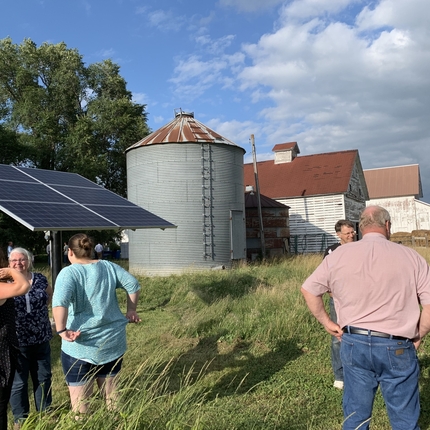By Cody Smith, former staff member
Battling a tough farm economy and increasingly unpredictable weather, farmers are often looking for ways to reduce costs on their operations.
One strategy is leveraging the affordability of solar panels on farms, an idea that has been picking up steam in many rural areas.
There are several uses for solar on the farm, including the realization of major energy cost savings associated with the operation of grain drying and irrigation equipment. During corn harvest years, drying the grain down to the desirable moisture level for safe storage can create a significant energy demand. Additionally, pumps on irrigation pivots may require constant, expensive refueling with diesel fuel. Many farmers with solar have enjoyed energy cost reductions by offsetting the demands of this expensive, but important equipment.
Across the Midwest and Great Plains, farmers and rural businesses have led a boom in the solar industry. The Census of Agriculture showed a growing popularity for solar energy on the farm, with 90,142 farms having solar energy production in 2017—a 60 percent increase from the 36,331 farms reported in 2012. Though still in a stage of growth, the solar industry supports thousands of jobs, with 844 in Iowa, 1,328 in Nebraska, and 444 in South Dakota.
However, to maintain solar as a financially-viable option for farmers in the region, net metering must be protected. Under net metering, solar panel owners receive a bill credit at a predetermined rate from their local utility in exchange for the excess energy they transfer to the grid.
State and federal policies play a major role in supporting the growth of on-farm solar. Misguided net metering policies, such as the Sunshine Tax proposed in Iowa during the 2019 legislative session, could substantially increase the amount of time it takes to pay back the cost of solar projects. Meanwhile, South Dakota is one of only three states in the nation without net metering legislation. These gaps in state policy are exemplified at a time when federal-level incentives are phasing out—the federal Investment Tax Credit dropped from 30 percent of total project cost to 26 percent this year.
As we look forward, the Center for Rural Affairs will continue to advocate for supportive and evidence-based policy solutions which help advance solar as an option for farmers in the region. Ultimately, we will work to inform our elected officials about how important investments in solar energy are to reducing energy costs, especially on the farm.





